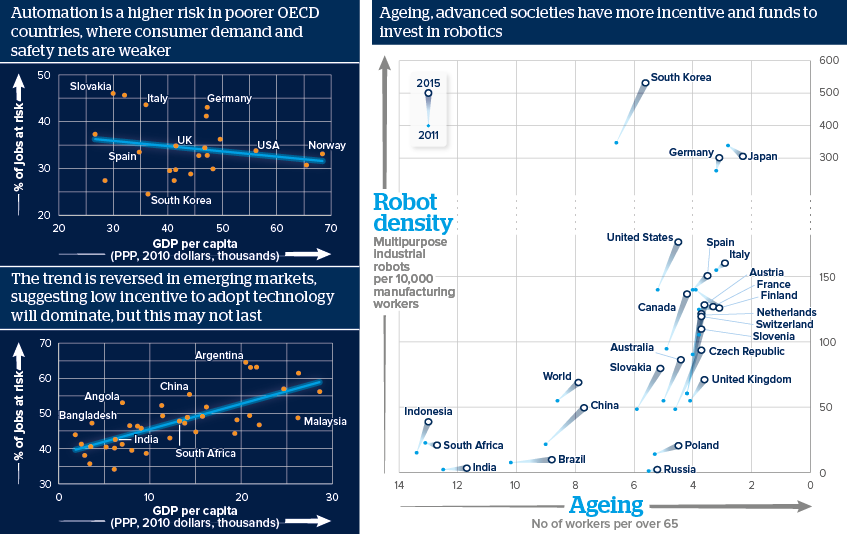Redistribution is key to the future of the workforce
Technology will raise productivity and living standards; redeployment rather than fear of unemployment must guide policy
Source: OECD, World Bank, IMF World Economic Outlook, International Federation of Robotics, UN Population Prospects
Outlook
Twentieth century data supported the view that machines could only replace routine tasks. A 2003 paper by Autor, Levy and Murnane became the ‘ALM’ consensus, assuming non-routine tasks could not be automated as they relied on knowledge humans could not explain to robots.
Changing our understanding, machine learning capability has since progressed faster than human capability. In 2016, AlphaGo, Google DeepMind’s artificial intelligence computer programme, beat the human Go champion with a new move. Algorithms designed the widely praised interior of the newly opened Hamburg Concert Hall.
Consumers benefit from greater accessibility and affordability. Potential for ageing societies is vast; a 130,000-image algorithm is more reliable diagnosing skin cancer than 22 doctors. However, redistribution is critical to minimising disruption.
Impacts
- One certainty of the race between workers and machine owners is inequality, making structural reforms and redistribution policies crucial.
- London School of Economics Professor Leslie Willcocks estimates that for every 20 jobs robotics destroys from 2017-27, it will create 13.
- Legal and regulatory regimes will struggle to keep up, and education shortfalls in advanced countries will intensify competition for talent.
- Premature deindustrialisation is worrying for developing countries with large, young workforces that are industrialising from agriculture.
See also
- Prospects for manufacturing in 2020 - Nov 13, 2019
- Weak GDP may delay policymakers’ ‘Industry 4.0’ plans - May 13, 2019
- Prospects for the future of work in 2019-23 - Dec 3, 2018
- Digitalisation will divide and drive economic progress - Jul 17, 2018
- Automation job gains will be unevenly spread - Jun 26, 2018
- If participation picks up, US rate rises will speed up - Apr 17, 2018
- Prospects for frontier economies in 2018 - Nov 30, 2017
- Prospects for the global economy in 2018 - Nov 1, 2017
- The technological singularity is distant - Oct 11, 2017
- Adoption of machine learning will rise - Sep 25, 2017
- Technological advances are improving mining efficiency - Sep 6, 2017
- Policy must look beyond pay to raise living standards - Jul 13, 2017
- Raising workers' quality is key to global productivity - Jul 4, 2017
- Prospects for fintech to end-2017 - Jun 13, 2017
- Prospects for the global economy to end-2017 - Jun 1, 2017
- Prospects for artificial intelligence in 2017-22 - Dec 6, 2016
- More graphic analysis
